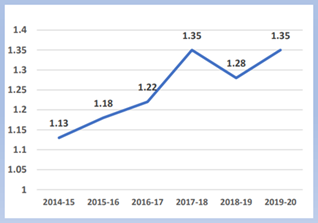Why in News?
- Ministry of Health and Family Welfare has released the National Health Account Estimates 2019-20.
What’s in today’s article?
- About NHA (Origin, Purpose)
- Major Findings of NHA 2019-20
- Way Ahead
National Health Accounts (NHA):
- Report on National Health Accounts Estimates is published by the National Health Systems Resource Centre (NHRSC) under the Union Ministry of Health & Family Welfare.
- The NHA for 2019-20 is the seventh round of estimates since 2013-14.
- It is based on the globally accepted framework of ‘System of Health Accounts, 2011’ for inter-country comparison and learning.
- System of Health Accounts (SHA) was originally developed by the World Health Organization (WHO).
- SHA is an internationally standardized framework that systematically tracks the flow of expenditures in the health system.
- NHA provides detailed information on overall health expenditure both by the public and private sector in the country.
Major Findings of NHA Estimates 2019-20:
- Government Expenditure on Health –

- During this period, the share of Government Health Expenditure (GHE) in the overall GDP of the country has increased from 1.13% in 2014-15 to 1.35% in 2019-20.
- In per capita terms, GHE has doubled from Rs. 1,108 to Rs. 2,014 between 2014-15 to 2019-20.
- Out-of-Pocket Expenditure (OOPE) –
- The share of Out-of-Pocket Expenditure (OOPE) in total Health Expenditure (THE) declined from 62.6% to 47.1%.
- The continuous decline in the OOPE in the overall health spending show progress towards ensuring financial protection and Universal Health Coverage for citizens.
- The increase in government spending on health has an important implication for the reduction of financial hardship endured by households.
- In the Total Health Expenditure (THE) of the country between 2014-15 and 2019-20, the share of GHE has increased from 29% to 41.4%.
- Social Security Expenditure (SSE) –
- Another positive trend in the country’s health financing space is the increase in Social Security Expenditure (SSE) on healthcare.
- This increase in social security has a direct impact on reducing out-of-pocket payments.
- A robust social security mechanism ensures that individuals will not face financial hardship and the risk of poverty as a consequence of accessing essential healthcare services.
- The share of SSE on health, which includes government-funded health insurance, medical reimbursement to government employees, and social health insurance programs, in THE, has increased from 5.7% in 2014-15 to 9.3% in 2019-20.
Comparing India’s Government Health Expenditure with other Countries’:
- As per the NHA estimates for 2019-20, India spends 1.35% of total GDP on public health expenditure.
- Compare this with countries like the United Kingdom, Netherlands, New Zealand, Finland and Australia where all these countries spend over 9% of their total GDP in public healthcare system.
- Neighbouring countries like Bangladesh and Pakistan have over 3% of their GDP going towards public healthcare system.
Way Ahead:
- Increasing public spending on health –
- An efficient and equitable health system cannot be developed without adequate public financing.
- The National Health Policy (2017) recommends government expenditure on health to be increased to 2.5% of GDP by 2025.
- Improve Doctor-to-Patient ratio –
- As of February 2021, India’s doctor-to-population ratio stood at 1:1404, while the WHO recommends the doctor-to-population ratio to be 1:1000.
- For people in the rural India who are completely dependent on government healthcare facilities, the doctor to patient ratio is abysmally low with 1:10,926 doctors.
- Optimizing the use of technology –
- Technology-enabled community health workers, nurses and other frontline care providers can perform many functions in primary care.










